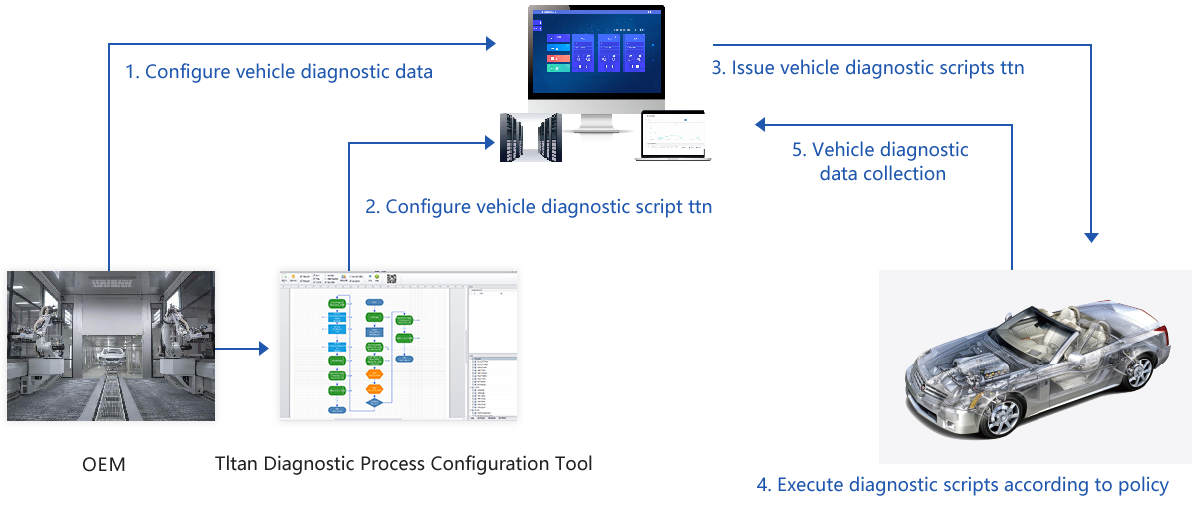OEM cloud security
Server access protection
Server attack defence
Secure storage of diagnostic data
Proactive and intelligent car diagnostics are the future of connected cars
The widespread application of automotive electronic systems and in-vehicle network technology is driving the rapid development of standardized automotive diagnostic technology. ABUP-RVDS combines automotive diagnostic technology, wireless communication technology and an in-vehicle network platform, giving the opportunity to combine the car, the owner, the diagnostic expert and the diagnostic management platform. The in-vehicle network-based diagnostic technology acquires vehicle information and sends it to the diagnostic platform, enabling real-time interaction and information sharing between inside and outside the vehicle. Diagnostic experts can access and analyse vehicle data, perform OTA upgrades and troubleshoot remotely without being physically present.
Diagnosis of road test vehicles
Diagnosis of off-site production plants
Pre-diagnosis for OTA upgrade
Fault monitoring for OT A upgrade Operational monitoring of operating vehicles
Fault warning for vehicles
Remote diagnosis of vehicles
Virtual diagnosis, remote assistance
Virtual diagnosis, remote assistance
Vehicle health rating
Vehicle maintenance advice, repair instructions Driving guidance for faulty vehicles
ABUP provides professional automotive electronic diagnosis/refreshing whole system solutions (parts, engineering, after-sales) and has developed various diagnostic related products independently to meet the needs of different user application scenarios for diagnosis/refreshing, and is able to provide comprehensive services for vehicle manufacturers.
We provide standardized OSEK base software modules, especially for TBOX products (SAIC Zero East, Geely, SAIC, Liuzhou, Zero Beam. BAIC, Zotye, Yundu, Changan). We develop and service TBOX products with traditional diagnostic, data communication, big data processing, remote diagnostic, remote refresh and other functions.
We provide professional and high quality OTA development services for entire vehicles. (Case study: mass production application in 25 car companies and over 40 car models nationwide)
Benchmarking Vector CANoe products, self[1]developed bus, diagnostic and refresh engineering tools, offering product-based customisation. (Case (Example: Guanzhi Automobile, Winchester, BAIC, SAIC Zero Beam, and several parts suppliers)
Development of new diagnostic software for vehicle manufacturers (examples: 48 models, 39 types of controllers, 60 parts suppliers, 307 controllers in total); Development of new generation of ODX/OTX based diagnostic software: provision of diagnostic/refresh engine module.

The business is divided into different microservice applications according to business rules and deployed in distributed clusters. Using hardware load balancing devices or application software load balancing, service requests can be switched to the corresponding redundant services when needed to ensure that - if one node is down - there are still other nodes available to provide services.
Each cluster node application is registered to the registry, and the service registry detects the status of each microservice application. When the service provider is detected to be unavailable, it will broadcast the fault service information to all nodes in the cluster, and when the consumer receives the service fault notification message, the fault node will be isolated according to the service name and IP address in the fault information. The fault isolation minimises the damage caused by the fault and improves the overall capability of the system to provide external services.
The system implements routing fault tolerance through the Gateway, which provides reliable system access when microservice applications in the cluster fail to invoke it, using the routing fault tolerance mechanism.
The fusion policy protects the upstream services in the cluster from being overstressed, in the event that some nodes in the cluster crash completely without our knowledge. The system uses anomaly detection to complete the fusion function, by periodically and dynamically detecting anomalies in the upstream cluster to determine if some hosts are abnormal, and if anomalies are found, the hosts are isolated from the connection pool, this is called outlier detection.
The system shall, through the flow control mechanism for service requests, control the flow of a small number of transactions with a high degree of impact during the time when the performance of the system fluctuates, so as to ensure the smooth operation of the system. The platform shall implement flow control for the system based on the logical architecture of the system, based on the transaction flow and transaction status at different levels of each sub-system and the determined control strategy and control rules. When there are problems or attacks on external access, etc., flow control is activated and services are downgraded.
Platform throughput up to 100,000TPS
Platform supports up to
1 million vehicles concurrently
Platform response time less than 200ms

Diagnostic cloud server and management platform
Server support for expansion
with >100 servers
SSL guaranteed data transfer,
AES encrypted signature verification
Real-time traceability of historical
data for vehicles issued with diagnostic tasks

Server access protection
Server attack defence
Secure storage of diagnostic data

HTTPS secure links
Transfer of encrypted content

Diagnostic data CRC checks
Diagnosing packet integrity and security
sha256 checksum

Cloud Security Releases Diagnostic Tasks

Download signature checks for diagnostic tasks

Subcontract Content Correctness CRC Checks

Whole-Packet Integrity Sha256 Checks

Breakpoint/electricity renewal mechanism

ABUP WeChat official account